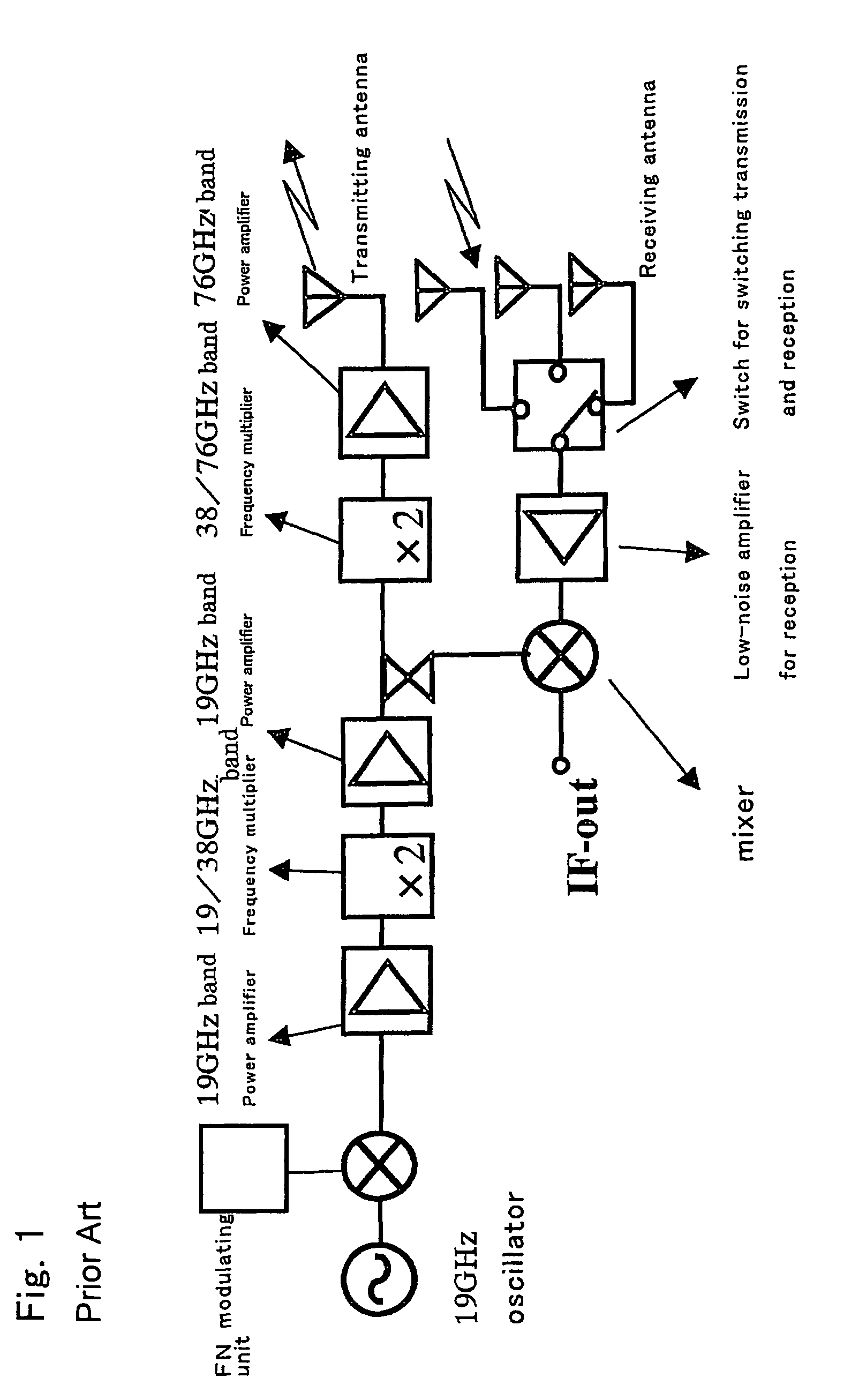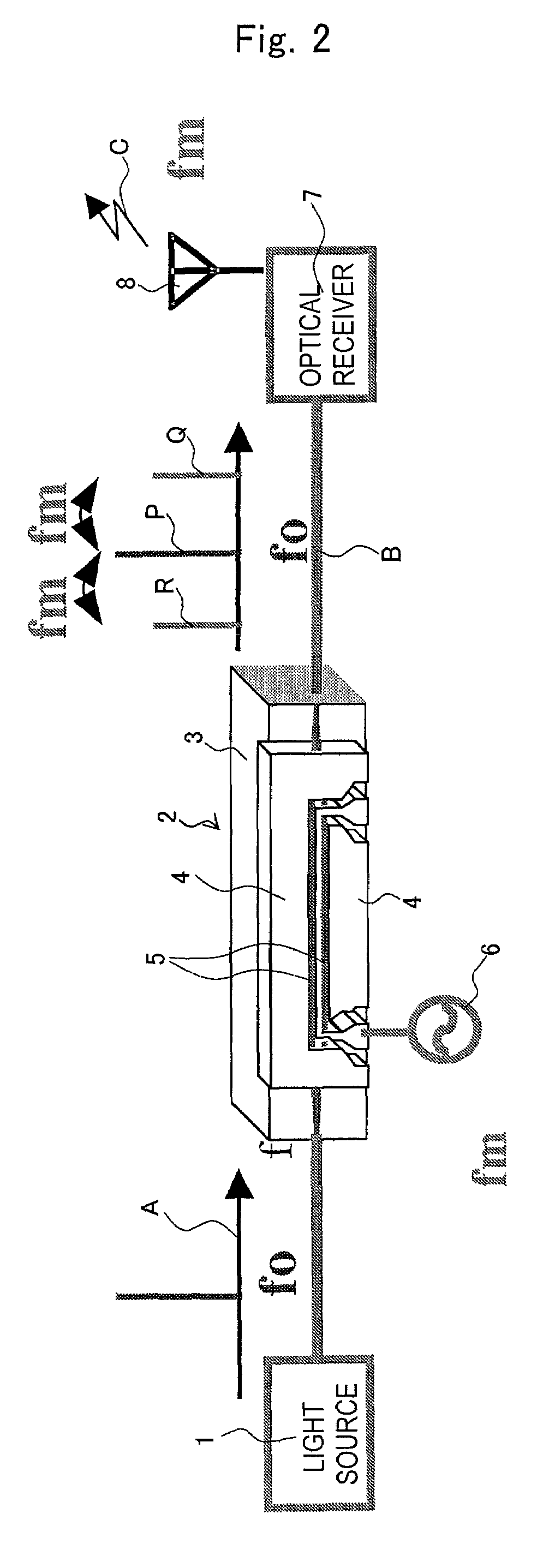Radio oscillating and radar systems
a radio signal and radar technology, applied in the direction of braking system, using reradiation, instruments, etc., can solve the problems of difficult to ensure the necessary output power of radio signal, high cost of oscillation, low energy efficiency, etc., to achieve efficient generation of sideband waves, low cost, and alleviation of filters
- Summary
- Abstract
- Description
- Claims
- Application Information
AI Technical Summary
Benefits of technology
Problems solved by technology
Method used
Image
Examples
example 1
[0106]The radar system was produced using an optical modulator 2 shown in FIG. 13.
[0107]Specifically, Ti-diffusion waveguides 5A, 5B and CPW electrodes 4A, 4B and 4C were formed on a substrate of x-cut lithium niobate 3. As to the electrode structure, the gaps “G” between the central electrode 4B and ground electrodes 4A, 4C were 20 μm, the electrode thickness was 20 μm, and the electrode length was 40 mm. The modulator substrate was adhered, for thinning, to a dummy plate fixed onto a surface plate with a thermoplastic resin, so that the electrode face is oriented downwardly. The substrate was then subjected to horizontal polishing and polishing to a thickness of 6 μm. A plate-shaped reinforcing body of x-cut lithium niobate was then adhered to the modulator substrate. The body was subjected to polishing at the end face to be connected to an optical fiber and cut into chips by dicing. An adhesive having a specific dielectric constant of 4 was used as the adhesive for the fixation a...
example 2
[0110]Then, a delta wave of the above radiation frequency was modulated to operate the optical modulator 2 according to the same method. It was thus proved that FMCW signal of a central frequency of 76 GHz was radiated. The signal was irradiated to a moving object from the transmitting antenna 8, and the reflected signal was received with the receiving antennas 15A, 15B and 15C.
[0111]The transmitted signal and received signals were mixed by the mixer 18 to draw the beat signal shown in FIG. 14, so that the distances and relative velocities could be detected. It was confirmed that the actual distance of 100 m and actual velocity of 50 km of the moving object were measured.
example 3
[0112]Radio signal radiation was performed according to the same procedure as the example 1. According to the present example, however, Ti-diffusion waveguides 5A, 5B and CPW electrodes 4A, 4B and 4C were formed on a substrate 3 of x-cut lithium niobate. The width of the central electrode 4B was made 50 μm. The gaps G of the central electrode 4B and the ground electrodes 4A and 4C, respectively, were made 15 μm, the electrode thickness was made 15 μm and the electrode length was made 40 mm.
[0113]The modulator substrate was adhered to a dummy plate fixed onto a surface plate with a thermoplastic resin for the thinning, so that the electrode face is oriented downwardly. The substrate was then subjected to horizontal polishing and polishing to a thickness of 6 μm. A plate-shaped reinforcing body of x-cut lithium niobate was adhered and fixed to the modulator substrate. The body was subjected to polishing at the end face to be connected to an optical fiber and cut into chips by dicing. ...
PUM
| Property | Measurement | Unit |
|---|---|---|
| gap width | aaaaa | aaaaa |
| thickness | aaaaa | aaaaa |
| thickness | aaaaa | aaaaa |
Abstract
Description
Claims
Application Information
 Login to View More
Login to View More - R&D
- Intellectual Property
- Life Sciences
- Materials
- Tech Scout
- Unparalleled Data Quality
- Higher Quality Content
- 60% Fewer Hallucinations
Browse by: Latest US Patents, China's latest patents, Technical Efficacy Thesaurus, Application Domain, Technology Topic, Popular Technical Reports.
© 2025 PatSnap. All rights reserved.Legal|Privacy policy|Modern Slavery Act Transparency Statement|Sitemap|About US| Contact US: help@patsnap.com



